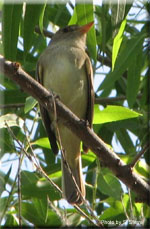- Home
- About S&T
- Taxa/Organisms
- Ecosystems
- Issues
- Methods & Tools
- Reports & Publications
- Location
- Search
2008 | Publisher: USGS | Science Center: Fort Collins Science Center (FORT, Ft. Collins) | Format: URL
www.fort.usgs.gov — San Acacia Dam is located in a reach of the Rio Grande that has been designated as critical habitat for two endangered species, the Rio Grande silvery minnow (Hybognathus amarus) and the southwestern willow flycatcher (Empidonax traillii extimus). Presently, Rio Grande upstream from the dam is used to convey irrigation water to the Socorro main More...

November 2007 | Publisher: Academic Institution (Sage-grouse Restoration Project (SGRP), Utah State University) | Format: .PDF
sgrp.usu.edu — The greater sage-grouse (Centrocercus urophasianus) and the Gunnison sage-grouse (C. minimus) are species of concern because of their population declines and shrinking geographic distributions. Of continuing interest is the question of population abundance and trends. This publication answers the questions that deal with sage-grouse population, More...

2007 | Publisher: USGS | Format: URL
pubs.usgs.gov — The Southwestern Willow Flycatcher (Empidonax traillii extimus) is an endangered bird that breeds only in dense riparian habitats in six southwestern states (southern California, extreme southern Nevada, southern Utah, southwestern Colorado, Arizona, and New Mexico). This report synthesizes information on all known Southwestern Willow Flycatcher More...

Publisher: USGS | Format: URL
pubs.er.usgs.gov — This report presents the results of the 2006 International Census of Piping Plovers (Charadrius melodus). Two sets of tabular data are reported: one for distribution and abundance of wintering Piping Plovers, the other for distribution and abundance of breeding Piping Plovers. The winter census resulted in the observation of 3,884 Piping Plovers More...

Publisher: NBII | Format: URL
www.nbii.gov — Natural resource managers face complex decisions that require a clear understanding of the status of wildlife populations and their habitats. Monitoring is key to making effective management decisions and evaluating the outcomes of those decisions. The goal of NRMP is to improve the accessibility of monitoring efforts to resource managers to aid More...

Publisher: USGS | Science Center: Fort Collins Science Center (FORT, Ft. Collins) | Format: URL
www.fort.usgs.gov — Natural Resource Monitoring Partnership (NRMP) is a collaborative effort by the natural resource management community to improve monitoring efforts in order to support effective evaluation and decision-making by sharing information on monitoring projects and protocols. The Natural Resource Monitoring Partnership was built for easy access to More...

Publisher: USGS | Format: .PDF
pubs.usgs.gov — The Piping Plover (Charadrius melodus) is a migratory shorebird currently listed as Endangered in Canada and the U.S. Great Lakes, and threatened throughout the remainder of its U.S. breeding and winter range. In this study, scientists undertook the first comprehensive molecular genetic-based investigation of Piping Plovers. The primary goals were More...

Publisher: USGS | Science Center: Pacific Island Ecosystems Research Center (PIERC, Honolulu) | Format: URL
biology.usgs.gov — How is avian pox and malaria impacting native Hawaiian honeycreepers? USGS scientists in Hawaii conduct surveys, develop new diagnostic tools, and test management strategies to understand the impacts of these introduced vector borne diseases on native Hawaiian wildlife.

Publisher: USGS | Science Center: Pacific Island Ecosystems Research Center (PIERC, Honolulu) | Format: URL
biology.usgs.gov — USGS scientists build on the research of ornithologists in the 1800's and 1950's to show whether native Hawaiian birds are in fact highly susceptable to mosquito-transmitted avian diseases such as pox and malaria. The results help explain current population patterns and could potentially aid resource managers in selecting birds for restoration in More...

Publisher: USGS | Science Center: Pacific Island Ecosystems Research Center (PIERC, Honolulu) | Format: URL
biology.usgs.gov — Many native Hawaiian forest birds have become endangered and extinct, possibly due to introduced avian diseases. Scientists use genetics, long term studies, and sentinel chickens and canaries to learn the prevalence and impacts of malaria and avian pox on native Hawaiian forest birds.

Publisher: Other (Society of Environmental Toxicology and Chemistry (SETAC)) | Format: .PDF
www.pwrc.usgs.gov — From the abstract: Environmental contaminants can have profound effects on birds, acting from the molecular through population levels of biological organization. An analysis of potential contaminant threats was undertaken at 52 Important Bird Areas (IBAs) within the northeastern Atlantic coast drainage. Using geographic information system More...

Publisher: USGS | Science Center: Pacific Island Ecosystems Research Center (PIERC, Honolulu) | Format: URL
biology.usgs.gov — Introduction to Hawaiian studies of native birds: Hawaiian forest birds, endangered Palila (Loxioides baillieu), endangered Nene (Branta sandvicensis), birds elsewhere in the Pacific, waterbirds and seabirds, and endangered Laysan ducks (Anas laysanensis).
